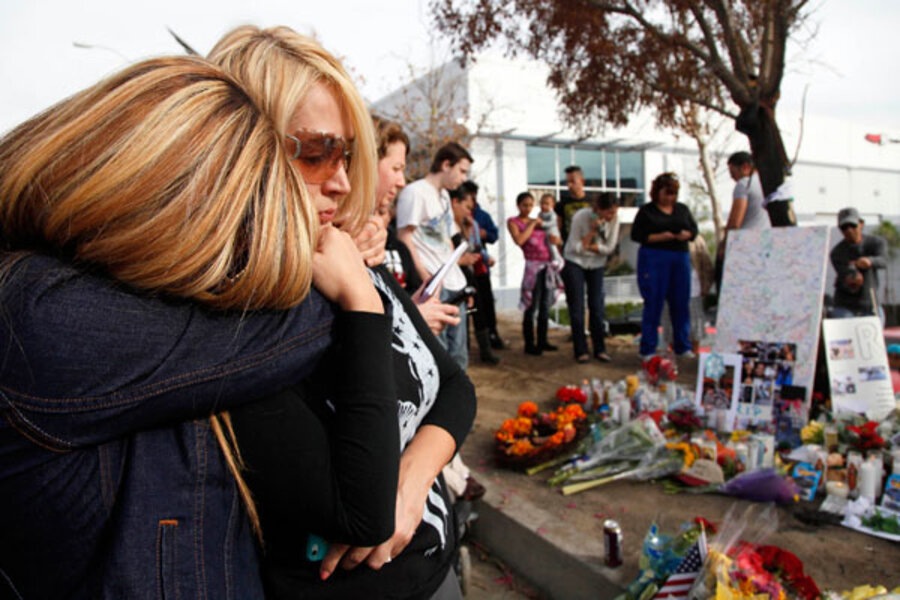Paul Walker crash could 'romanticize' growing street racing culture
Loading...
| Valencia, Calif.
Four days after the crash that killed “Fast & Furious” movie icon Paul Walker, there are still the sounds of sobbing amid the considerable crowds gathered at the photos-and-candles memorial that has built up at the site of his crash in front of a mall here.
But several yards back, out of the earshot of the ubiquitous broadcast reporters doing their standup shoots, a family is having a whispered conversation.
“Mom, they weren’t racing,” says 14-year-old Steven Cassidy from nearby Castaic, Calif., who has come to pay his respects to his fallen hero.
“Yes, but they were going too fast in a souped-up car – a life glorified by those movies, which I think is not a good model to set for young people,” says his mom, Delores, trying to keep her voice down.
Sheriff’s investigators say they’ve ruled out drag racing, but the $500,000 Porsche Carrera GT was going at least 90 m.p.h. on a street with a speed limit of 45 m.p.h., according to a Los Angeles County sheriff's detective quoted in People magazine. The car is capable of reaching 60 m.p.h. in less than four seconds and 100 m.p.h. in less than seven.
The spot is well-known as a place where young drivers test their chutzpah, in a region that as a storied history of street racing. Skid marks are ubiquitous and teens tell you about the stunt called, “drifting” – which is a way to get the car’s back end to shimmy and slide.
“This is Hercules curve, man. It is so chill for drifting,” says 18-year-old Lorraine Touvo, who grew up in nearby Sunland, Calif. “It’s got just the perfect curve.”
The comment raises the question of what effect the accident might have on the street-racing phenomenon that exploded in the early 2000s and was glorified by the original “Fast & Furious.”
Interviews with teens at the crash site, as well as in nearby Sunland – where there is a very strong subculture of street racing – seem to indicate “not much.”
“We’re shattered by this death,” says a teenage boy who asked not to be identified. “But will it mean we’re all gonna start driving differently? Probably not.”
Some say the reverse could even be true. Jack Nerad, former editor of Motor Trend, now executive director at Kelly Blue Book, has been following the street racing subculture for decades. He says the Walker crash won’t dampen enthusiasm at all and “sadly, might even romanticize it.”
He watched as street racing moved from dry lakes to the streets, rising with the increased popularity of small imports, tapering off slightly, but then rising steadily for the past decade.
Law-enforcement officials seem to agree with Mr. Nerad's observations. Another street-racing wave is coming, and police are preparing for it.
San Diego police officer Mark McCullough, who has been on street-racing detail since before 2000, says street racing got out of control just as the first “Fast and Furious” movie was released in 2001.
“We were seeing thousands of kids in these racing areas doing illegal racing, getting in fights, gambling, and worse,” he says.
With the help of the state and other city police departments, the San Diego police formed a dragnet and started a program to teach kids to take their street racing to local tracks. Mr. McCullough calls it a one-two punch.
“We offered them a safe and legal option, and we really slammed those that didn’t comply,” he says.
That meant impounding cars and crushing them into a one-cubic-foot cube.
Nearby, “Ontario police did more than we did. They shredded them and burned them and used them for training,” he says.
The problem was at its worst in 2002 and 2003, when several fatal crashes occurred, he adds. Police started sting operations, used helicopters, and cordoned off city streets and even highways, he says. Police also made and distributed videos.
“It started to taper off when we did that,” McCullough says.
For reasons he has yet to identify, the street racing has started to inch back up in popularity. Southern California law enforcement is trying to coordinate efforts to better train officers and figure out how to nip enthusiasm in the bud.
Anthony Vestal, spokesman for the National Hot Rod Association, says that is the technique that formed his association back in 1951.
"When Wally Parks founded the NHRA in 1951, he worked to get racing off the city streets and highways and into safer, organized venues,” says Mr. Vestal. “We’re trying to get them used to racing on tracks from a very young age.”







